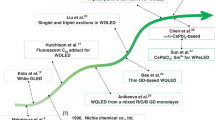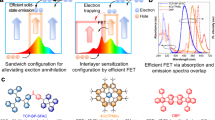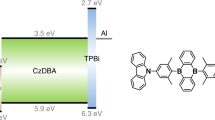Abstract
The development of white organic light-emitting diodes1 (OLEDs) holds great promise for the production of highly efficient large-area light sources. High internal quantum efficiencies for the conversion of electrical energy to light have been realized2,3,4. Nevertheless, the overall device power efficiencies are still considerably below the 60–70 lumens per watt of fluorescent tubes, which is the current benchmark for novel light sources. Although some reports about highly power-efficient white OLEDs exist5,6, details about structure and the measurement conditions of these structures have not been fully disclosed: the highest power efficiency reported in the scientific literature is 44 lm W-1 (ref. 7). Here we report an improved OLED structure which reaches fluorescent tube efficiency. By combining a carefully chosen emitter layer with high-refractive-index substrates8,9, and using a periodic outcoupling structure, we achieve a device power efficiency of 90 lm W-1 at 1,000 candelas per square metre. This efficiency has the potential to be raised to 124 lm W-1 if the light outcoupling can be further improved. Besides approaching internal quantum efficiency values of one, we have also focused on reducing energetic and ohmic losses that occur during electron–photon conversion. We anticipate that our results will be a starting point for further research, leading to white OLEDs having efficiencies beyond 100 lm W-1. This could make white-light OLEDs, with their soft area light and high colour-rendering qualities, the light sources of choice for the future.
This is a preview of subscription content, access via your institution
Access options
Subscribe to this journal
Receive 51 print issues and online access
$199.00 per year
only $3.90 per issue
Buy this article
- Purchase on Springer Link
- Instant access to full article PDF
Prices may be subject to local taxes which are calculated during checkout




Similar content being viewed by others
References
Kido, J., Kimura, M. & Nagai, K. Multilayer white light-emitting organic electroluminescent device. Science 267, 1332–1334 (1995)
Sun, Y. et al. Management of singlet and triplet excitons for efficient white organic light-emitting devices. Nature 440, 908–912 (2006)
Williams, E. L., Haavisto, K., Li, J. & Jabbour, G. E. Excimer-based white phosphorescent organic light emitting diodes with nearly 100% internal quantum efficiency. Adv. Mater. 19, 197–202 (2007)
Sun, Y. & Forrest, S. R. High-efficiency white organic light emitting devices with three separate phosphorescent emission layers. Appl. Phys. Lett. 91, 263503 (2007)
Nakayama, T., Hiyama, K., Furukawa, K. & Ohtani, H. Development of phosphorescent white OLED with extremely high power efficiency and long lifetime. SID07 Dig. 1018–1021 (2006)
D’Andrade, B. W. et al. Realizing white phosphorescent 100 lm/W OLED efficacy. Proc. SPIE 7051, 70510Q (2008)
Su, S.-J., Gonmori, E., Sasabe, H. & Kido, J. Highly efficient organic blue-and white-light-emitting devices having a carrier- and exciton-confining structure for reduced efficiency roll-off. Adv. Mater. 20, 4189–4195 (2008)
Nakamura, T., Tsutsumi, N., Juni, N. & Fujii, H. Thin-film waveguiding mode light extraction in organic electroluminescent device using high refractive index substrate. Appl. Phys. Lett. 97, 054505 (2005)
Gärtner, G. & Greiner, H. Light extraction from OLEDs with (high) index matched glass substrates. Proc. SPIE 6999, 69992T (2008)
Baldo, M. A. et al. Highly efficient phosphorescent emission from organic electroluminescent devices. Nature 395, 151–154 (1998)
Goushi, K., Kwong, R., Brown, J. J., Sasabe, H. & Adachi, C. Triplet exciton confinement and unconfinement by adjacent hole-transport layers. J. Appl. Phys. 95, 7798–7802 (2004)
Schwartz, G., Fehse, K., Pfeiffer, M., Walzer, K. & Leo, K. Highly efficient white organic light emitting diodes comprising an interlayer to separate fluorescent and phosphorescent regions. Appl. Phys. Lett. 89, 083509 (2006)
Qin, D. & Tao, Y. White organic light-emitting diode comprising of blue fluorescence and red phosphorescence. Appl. Phys. Lett. 86, 113507 (2005)
Schwartz, G., Pfeiffer, M., Reineke, S., Walzer, K. & Leo, K. Harvesting triplet excitons from fluorescent blue emitters in white organic light-emitting diodes. Adv. Mater. 19, 3672–3676 (2007)
Greenham, N. C., Friend, R. H. & Bradley, D. D. C. Angular-dependence of the emission from a conjugated polymer light-emitting diode - implications for efficiency calculations. Adv. Mater. 6, 491–494 (1994)
He, G. et al. High-efficiency and low-voltage p-i-n electrophosphorescent organic light-emitting diodes with double-emission layers. Appl. Phys. Lett. 85, 3911–3913 (2004)
Kawamura, Y., Brooks, J., Brown, J. J., Sasabe, H. & Adachi, C. Intermolecular interaction and a concentration-quenching mechanism of phosphorescent Ir(III) complexes in a solid film. Phys. Rev. Lett. 96, 017404 (2006)
Reineke, S., Schwartz, G., Walzer, K. & Leo, K. Reduced efficiency roll-off in phosphorescent organic light emitting diodes by suppression of triplet-triplet annihilation. Appl. Phys. Lett. 91, 123508 (2007)
Kawamura, Y. et al. 100% phosphorescence quantum efficiency of Ir(III) complexes in organic semiconductor films. Appl. Phys. Lett. 86, 071104 (2005)
Greenham, N. C. et al. Measurement of absolute photoluminescence quantum efficiencies in conjugated polymers. Chem. Phys. Lett. 241, 89–96 (1995)
Huang, Q., Reineke, S., Walzer, K., Pfeiffer, M. & Leo, K. Quantum efficiency enhancement in top-emitting organic light-emitting diodes as a result of enhanced intrinsic quantum yield. Appl. Phys. Lett. 89, 263512 (2006)
D’Andrade, B. W., Holmes, R.-J. & Forrest, S. R. Efficient organic electrophosphorescent white-light-emitting device with a triple doped emissive layer. Adv. Mater. 16, 624–628 (2004)
Madigan, C. F., Lu, M.-H. & Sturm, J. C. Improvement of output coupling efficiency of organic light-emitting diodes by backside substrate modification. Appl. Phys. Lett. 76, 081114 (2006)
Möller, S. & Forrest, S. R. Improved light out-coupling in organic light emitting diodes employing ordered microlens arrays. J. Appl. Phys. 91, 3324–3327 (2002)
Lin, C.-H., Cho, T.-Y., Chang, C.-H. & Wu, C.-C. Enhancing light outcoupling of organic light-emitting devices by locating emitters around the second antinode of the reflective metal electrode. Appl. Phys. Lett. 88, 081114 (2006)
Baldo, M. A., Adachi, C. & Forrest, S. R. Transient analysis of organic electrophosphorescence: II. Transient analysis of triplet-triplet annihilation. Phys. Rev. B 62, 10967 (2000)
Meerheim, R. et al. Influence of charge balance and exciton distribution on efficiency and lifetime of phosphorescent organic light-emitting devices. Appl. Phys. Lett. 104, 014510 (2008)
Adamovich, V. et al. New charge-carrier blocking materials for high efficiency OLEDs. Org. Electron. 4, 77–87 (2003)
Reineke, S. et al. Measuring carrier mobility in conventional multilayer organic light emitting devices by delayed exciton generation. Phys. Status Solidi B 245, 804–809 (2008)
Acknowledgements
We thank the European Commission within the sixth framework IST programme under contract IST-2002-004607 (project OLLA), for funding. We received further support via the Leibniz Prize of the Deutsche Forschungsgemeinschaft. We also thank Novaled AG, Dresden, for providing the hole-transport layer dopant NDP-2 as well as J. Förster and T. Günther for technical assistance throughout sample preparation.
Author Contributions S.R. designed the emission concept, performed the transient electroluminescence measurements, wrote the manuscript, analysed most of the data and, together with F.L., optimized and characterized the devices and designed the outcoupling structure. G.S. was involved in the development of the second maximum devices. N.S. performed the photoluminescence quantum yield measurements. K.W. and B.L. coordinated the high efficiency white OLED project. K.L. motivated this work and co-wrote the manuscript.
Author information
Authors and Affiliations
Corresponding author
Supplementary information
Supplementary Information
This file contains Supplementary Figures 1-5 with Legends, Supplementary Data and Supplementary References. Missing lines from the Supplementary Figure 1 Legend were corrected on 21 May 2009. (PDF 1000 kb)
Rights and permissions
About this article
Cite this article
Reineke, S., Lindner, F., Schwartz, G. et al. White organic light-emitting diodes with fluorescent tube efficiency. Nature 459, 234–238 (2009). https://doi.org/10.1038/nature08003
Received:
Accepted:
Issue Date:
DOI: https://doi.org/10.1038/nature08003
This article is cited by
-
High-efficiency crystalline white organic light-emitting diodes
Light: Science & Applications (2024)
-
Recent synthetic strategies of small heterocyclic organic molecules with optoelectronic applications: a review
Molecular Diversity (2024)
-
Lanthanide complexes with d-f transition: new emitters for single-emitting-layer white organic light-emitting diodes
Light: Science & Applications (2023)
-
Ultrapure green organic light-emitting diodes based on highly distorted fused π-conjugated molecular design
Nature Photonics (2023)
-
Electrically driven organic laser using integrated OLED pumping
Nature (2023)
Comments
By submitting a comment you agree to abide by our Terms and Community Guidelines. If you find something abusive or that does not comply with our terms or guidelines please flag it as inappropriate.



